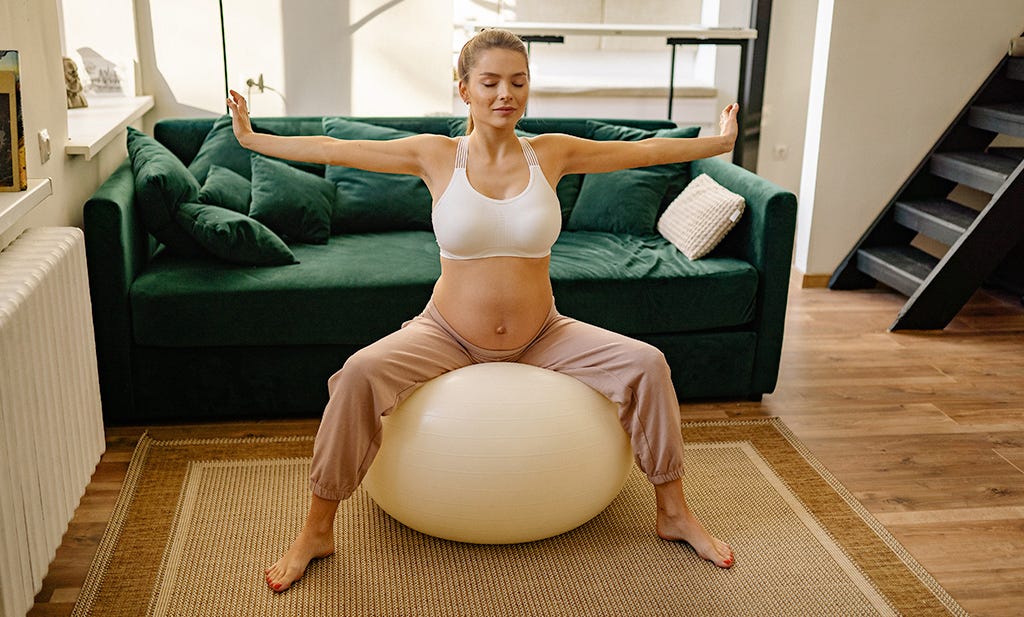
Your pelvic floor is a group of muscles that you might not think about very often, but if they aren’t strong and flexible, they can sorely impact your quality of life. This area of the body fulfils many important functions, as it is directly connected to our abdominal, back and respiratory muscles. The pelvic floor enables us to walk upright, closes our pelvis downwards, supports our internal organs and ensures that the bladder and bowel sphincters function. It also contributes to pleasurable sex. Today we talk about the role of the pelvic floor during pregnancy, during birth and afterwards. In this blog you will learn about the positive benefits that targeted pelvic floor training can have for you during pregnancy and afterwards.
What role does the pelvic floor play during pregnancy?
Your pelvic floor changes during pregnancy. On the one hand it needs stability to hold the uterus with the baby and on the other hand it needs a certain elasticity to give way to the increasing weight of the baby and to open your pelvis for the birth. Hormones therefore ensure that the network of muscles, ligaments and connective tissue becomes softer and looser.
Pelvic floor training during pregnancy: How can I feel my pelvic floor?
Sit upright on an exercise ball with your legs at right angles. Focus on your pelvic outlet between your pubic bone and tailbone and hum "Mmm" and "Umm" in a medium to low pitch. You will feel a small pelvic floor vibration and a warm sensation.
If you can feel this area well, try to tense it with your exhalation (this is easier as the pelvic floor is connected to the diaphragm) and pull it up inwards like a lift and hold it a little. The muscles of the buttocks remain loose. Did this work? If not, don't panic. It may take a while to locate the muscles correctly.
What are the benefits of pelvic floor training during pregnancy?
- Protects against bladder weakness / incontinence during and after pregnancy.
- Prevents back pain during pregnancy
- Facilitates birth during the expulsion phase
- Creates more pleasure during sex.
The role of the pelvic floor in birth.
You can use the function of your pelvic floor to make your birth easier. Vertical, i.e., upright, birthing positions such as standing, kneeling, or squatting are more suitable rather than horizontal, or lying down, positions. This is because gravity has a positive effect, and you can use your muscles optimally because of the freedom of movement. The pelvic floor muscles are stretched more evenly and adapt physiologically to the lowering head. In this way, the birth process can often be accelerated without causing additional pain. It also reduces the risk of perineal rupture and the need for an episiotomy.
Pelvic floor training after birth - an important part of regression.
Immediately after birth, the pelvic floor needs a lot of rest - and therefore the postpartum period to recover. The pelvic floor is also an important part of regression. In everyday life with your baby, but also in regression courses or in exercises, your attention should therefore always be on the pelvic floor.
6 Ways to improve your Pelvic Floor.
1. Train with your breathing: Whether breast/chest feeding, giving a bottle, brushing your teeth or making a cuppa - you can easily integrate this exercise into your everyday life. And you can already do it during pregnancy. Tense the pelvic floor with an exhalation and release it with an inhalation. After a few repetitions you can hold the tension for a few seconds.
2. Do it often rather than for a long time: regularity is the key to pelvic floor training. That's why it's better to train briefly more often than to take longer for a pelvic floor session once a week.
3. Sideways instead of straight: When getting up from lying down - whether during pregnancy or after birth - it is best to first roll onto your side and then straighten up and not sit down directly with the upper body upright. This puts a lot of pressure on the pelvic floor and bladder.
4. Cough and sneeze properly: Perhaps some of you know that the pelvic floor cannot withstand the pressure when you cough or sneeze. This is because you put pressure on your pelvic floor and bladder by bending your torso downwards. You can avoid this by turning your torso to one side and holding your head up when you cough or sneeze. This puts maximum strain on the lateral abdominal muscles.
5. Don't push: You should not squeeze when urinating to speed up the process. The best thing to do is to sit upright, breathe deeply in and out of your stomach, then let the urine run until your bladder is empty. This will protect your pelvic floor.
6. Use a baby carrier: Carrying your baby in your arms puts much more strain on your pelvic floor than carrying your baby close to your body in an ergonomic baby carrier.






















